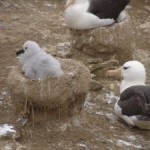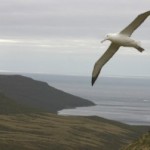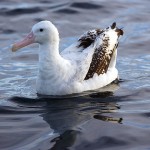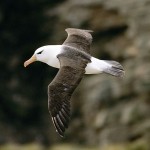Archive for the ‘Wildlife A-Z’
-
Amazing Flight of the Albatross – Part – IV
Posted in Wildlife A-Z | March 22, 2010 As I reached the north cliffs, the skies were covered with dense clouds. I was touched by the thousands of birds gliding through the shafts of the sun. They glided between the low heavens and pewter sea. Their braying and cooing lingers in the air. The scent of guano, too, is strong. The nests contain month-old chicks that sit like snowmen. As the adults arrive to feed them, I am spellbound. The adult albatross converts food into high-density oil that matches the calorific content of diesel. The parent and the chick greet each other with crossed bills. Following this, the adult squirts oil resembling the filling of a tank. Adults spend nearly 15 minutes feeding its chick. The chicks consume food three times its body weight. The adults then travel [...]
As I reached the north cliffs, the skies were covered with dense clouds. I was touched by the thousands of birds gliding through the shafts of the sun. They glided between the low heavens and pewter sea. Their braying and cooing lingers in the air. The scent of guano, too, is strong. The nests contain month-old chicks that sit like snowmen. As the adults arrive to feed them, I am spellbound. The adult albatross converts food into high-density oil that matches the calorific content of diesel. The parent and the chick greet each other with crossed bills. Following this, the adult squirts oil resembling the filling of a tank. Adults spend nearly 15 minutes feeding its chick. The chicks consume food three times its body weight. The adults then travel [...] -
Amazing Flight of the Albatross – Part – III
Posted in Wildlife A-Z | March 19, 2010 Campbell Island is the nesting place of the southern royal albatross. It lies 400 miles south of New Zealand. The island has fantastic waves and birds. The birds include giant petrels, shearwaters, and our very own albatross. The markings of the pintado petrels give them the appearance of flying dominoes. The tall cliffs obscure the island’s loneliness. There is a constant blowing of chilly winds. The Campbell albatross is unique to the island, with a grey head and light mantle. The brows are jet black in color. There are no vehicles on Campbell Island. The rhythm of the legs determines the time and distance covered. A 45-minute walk is the most direct route at leads to the birds. I have spotted many birds in the broad alley. I seem to misjudge [...]
Campbell Island is the nesting place of the southern royal albatross. It lies 400 miles south of New Zealand. The island has fantastic waves and birds. The birds include giant petrels, shearwaters, and our very own albatross. The markings of the pintado petrels give them the appearance of flying dominoes. The tall cliffs obscure the island’s loneliness. There is a constant blowing of chilly winds. The Campbell albatross is unique to the island, with a grey head and light mantle. The brows are jet black in color. There are no vehicles on Campbell Island. The rhythm of the legs determines the time and distance covered. A 45-minute walk is the most direct route at leads to the birds. I have spotted many birds in the broad alley. I seem to misjudge [...] -
Amazing Flight of the Albatross – Part – II
Posted in Wildlife A-Z | March 19, 2010 Albatrosses thrive in areas that cannot be imagined. Elemental islands are the primary areas. However, there exists no place untouched by humans. As a result, the population has been dwindling steadily. To make sure I got the best view, I chose the most populous albatross colony on the planet. The species are under threat of extinction. To increase their numbers, we need to sign a deal with them. Failing which, we may never again lay sight on so beautiful a species. Falklands’ Steeple Jason Island is graceful with tussock grass growing to head height. As I walked around the island, I witnessed a living miracle: a group of black-browed albatrosses crowding the ledges and shoreline. The heads of the birds are decorated with black stripes, just [...]
Albatrosses thrive in areas that cannot be imagined. Elemental islands are the primary areas. However, there exists no place untouched by humans. As a result, the population has been dwindling steadily. To make sure I got the best view, I chose the most populous albatross colony on the planet. The species are under threat of extinction. To increase their numbers, we need to sign a deal with them. Failing which, we may never again lay sight on so beautiful a species. Falklands’ Steeple Jason Island is graceful with tussock grass growing to head height. As I walked around the island, I witnessed a living miracle: a group of black-browed albatrosses crowding the ledges and shoreline. The heads of the birds are decorated with black stripes, just [...] -
Amazing Flight of the Albatross – Part – I
Posted in Wildlife A-Z | March 18, 2010 What comes to your mind when you think of a flying machine? Can it be the albatross which is designed to be one of the best flying species on the planet? The albatross is made up bone, feathers, muscle and wind, which give the bird its flying prowess. Watching the bird in full flight gives the impression as if it were propelled into the sky. The albatross is more of an art deco bird, which has striking patterns. It is known for its faithfulness and epic travels. Parent albatrosses are known to fly for more than 10,000 miles to feed their chicks. They have the longest wings in the world, stretching up to 3.5 meters. These beauties can glide for hundreds of miles without flapping their wings. Besides crossing ocean basins, they have circumnavigated [...]
What comes to your mind when you think of a flying machine? Can it be the albatross which is designed to be one of the best flying species on the planet? The albatross is made up bone, feathers, muscle and wind, which give the bird its flying prowess. Watching the bird in full flight gives the impression as if it were propelled into the sky. The albatross is more of an art deco bird, which has striking patterns. It is known for its faithfulness and epic travels. Parent albatrosses are known to fly for more than 10,000 miles to feed their chicks. They have the longest wings in the world, stretching up to 3.5 meters. These beauties can glide for hundreds of miles without flapping their wings. Besides crossing ocean basins, they have circumnavigated [...]



